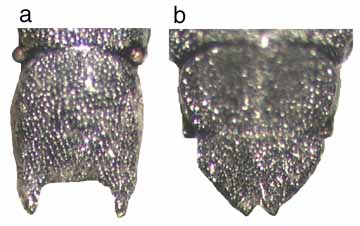
| Genus List | Species List | Camponotus Overview |
10a. Propodeum with distinct pair of posteriorly projecting subtriangular spines or teeth: 20
10b. Propodeum lacking spines or tubercles of any kind: 80
20a. Dorsal face of propodeum subrectangular, longer than wide in dorsal view; propodeal spines widely spaced: 30
20b. Dorsal face of propodeum converging posteriorly, subtriangular; propodeal spines closely spaced: JTL-033

30a. First gastral tergite with dense layer of appressed pubescence beneath erect setae, pubescence nearly covering integument; petiole subquadrate, not scale-like; petiole with posteriorly projecting medial spine: mucronatus
30b. First gastral tergite with very dilute pubescence, not obscuring integument; petiole subquadrate or scale-like; petiolar spine present or absent: 40
40a. Petiole with posteriorly projecting medial spine; propodeal suture deeply impressed: JTL-039
40b. Petiole lacking spine; propodeal suture deeply impressed or not: 50
50a. Petiole subquadrate, not scale-like; pronotum punctate; propodeal suture weakly impressed: 60
50b. Petiole more compressed, scale-like; pronotum shiny; propodeal suture deeply impressed: raphaelis
60a. Propodeal spines relatively longer and sharper (major: lacking pair of projecting lobes on clypeus, head less elongate, propodeal spines distinct, spiniform): bidens
60b. Propodeal spines relatively shorter and more triangular (major: head more phragmotic, with pair of broad projecting tubercles on clypeus, head more elongate and subrectangular in face view, propodeal spines absent or in the form of broad blunt tubercles): sanctaefidei

80a. Propodeum somewhat box-like, dorsal and lateral faces flat or nearly flat and meeting at an approximate right angle; dorsal face of propodeum subrectangular: 90
80b. Dorsal face of propodeum subtriangular, differentiated anteriorly, with a sharp to broadly rounded angle separating dorsal and lateral faces, but propodeum becoming tectiform (tent-like, like an inverted "V") posteriorly, angle fading and lateral faces converging; or dorsal face of propodeum very narrow and elongate, longer than posterior face (if dorsal and posterior faces differentiated at all), in cross section propodeum tectiform, without a distinct angle separating lateral and dorsal faces: 200
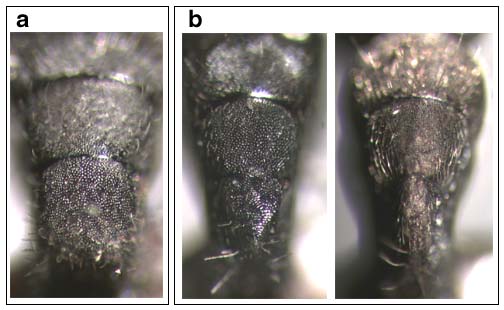
90a. First gastral tergite with dense appressed pubescence that nearly covers the integument (not to be confused with erect setae above pubescence): 100
90b. Pubescence on first gastral tergite dilute, appressed to suberect, not obscuring integument (erect setae may be abundant): 120
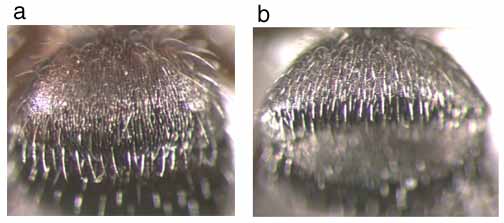
100a. Usually bicolored, with red head and mesosoma, darker brown gaster; erect setae on first gastral tergite relatively long; side of mesosoma sublucid; mesosomal profile relatively strongly arched: planatus
100b. Not bicolored, usually uniformly dark brown to dark red brown; erect setae on first gastral tergite long or short; side of mesosoma more densely punctate, less shining; mesosomal profile less arched: 110

110a. First gastral tergite with very dense, long, bright gold appressed pubescence; abundant gold erect setae cover mesosoma and head; erect setae on first gastral tergite relatively longer, intermediate between planatus and brettesi (makes nests of leaves sewn together with silk): textor
110b. First gastral tergite with relatively less dense, shorter, yellowish to silvery appressed pubescence (not as strikingly golden as textor); erect setae on mesosoma and head silvery or whitish; erect setae on first gastral tergite relatively short (nests in dead wood): brettesi

120a. Color uniformly orange: 130
120b. Color dark brown to black (legs variable): 140
130a. Integument generally mat; erect setae sparse, short, stiff: rectangularis
130b. Integument shiny; erect setae abundant, long, flexuous: pittieri
140a. Size very small; propodeal suture deeply impressed; dorsal and lateral faces of propodeum meeting at relatively sharp angle; mesonotal dorsum longitudinally striatopunctate: striatus
140b. Size larger; propodeal suture not deeply impressed, or if impressed, propodeum projects above level of mesonotum; dorsal and lateral faces of propodeum meeting at more rounded angle; mesonotal sculpture various, but not longitudinally striatopunctate: 150
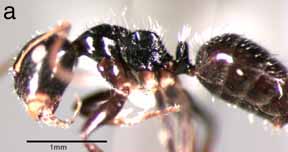
150a. Propodeum strongly projecting dorsally, not continuous with dorsal profile of mesosoma: abscisus
150b. Propodeum not strongly projecting, forming part of continuous dorsal profile of mesosoma: 160

160a. In face view with relatively abundant erect setae projecting from side of head, from mandibular insertion to level of eye: 170
160b. In face view side of head mostly lacking erect setae, a few setae near mandibular insertion and posterior to eye: 190
170a. Erect setae on first gastral tergite relatively short: senex
170b. Erect setae on first gastral tergite relatively long: 180
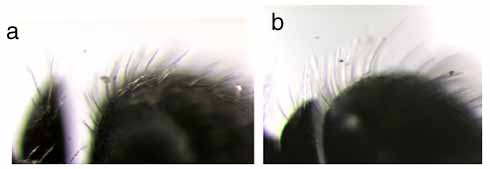
180a. Dorsal and posterior faces of propodeum meeting at relatively sharp angle: JTL-045
180b. Dorsal and posterior faces of propodeum meeting at relatively shallow angle: brevis
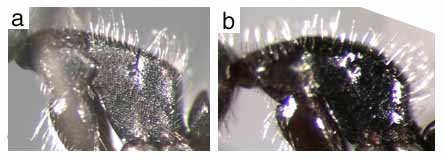
190a. Dorsal and posterior faces of propodeum meeting at relatively sharp angle: excisus
190b. Dorsal and posterior faces of propodeum meeting at relatively shallow angle: JTL-056

200a. First gastral tergite sharply divided into a flat anterior face and convex dorsal face, juncture of faces forming sharp angle or produced as transverse keel: 210
200b. First gastral tergite evenly rounded, not sharply divided into an anterior and dorsal face: 230
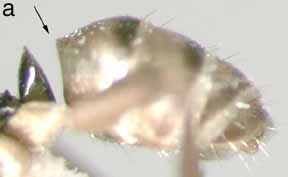
210a. Side of head strongly setose: JTL-032
210b. Side of head with very few setae or naked: 220
220a. Pronotum strongly shining; dorsal face of pronotum rounds into lateral face, with no angle or carina: championi
220b. Pronotum punctate; a distinct carina separating dorsal and lateral faces of pronotum: JTL-033
230a. Propodeum with continuous median longitudinal carina, forming a sharp keel: 235
230b. Mesonotum and propodeum may be strongly tectiform, but lacking median carina: 240
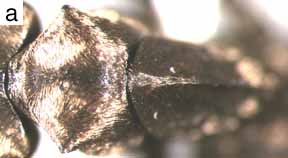
235a. Anterolateral margins of pronotum with projecting tubercles; propodeal keel not elevated; large species with dark ground color and bright golden (less often silvery) pubescence: sericeiventris
235b. Anterolateral margins of pronotum lacking tubercles; propodeal keel elevated and forming projecting lobe; smaller species with mostly red coloration: JTL-055

240a. Propodeal suture strongly impressed: 250
240b. Propodeal suture weakly impressed or absent: 270

250a. Color uniformly orange: constructor
250b. Color at least partially dark red brown: 260
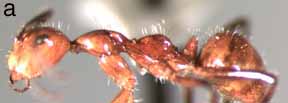
260a. Face, mesosoma, and gaster dark brown black overlain with variegated silky luster; scapes flattened: coruscus
260b. Face, mesosoma, and gaster shining dark red brown, with yellow spots on gaster; scapes terete: sexguttatus

270a. Dorsal face of propodeum very narrow and elongate, much longer than posterior face (if dorsal and posterior faces differentiated at all), in cross section propodeum tectiform (tent-like, like an inverted "V"), without a distinct angle separating lateral and dorsal faces, if propodeum somewhat "U" shaped rather than "V" shaped, dorsal face of propodeum much longer than posterior face: 300
270b. Dorsal face of propodeum subtriangular, differentiated anteriorly, with a sharp to broadly rounded angle separating dorsal and lateral faces, but propodeum becoming tectiform posteriorly, angle fading and lateral faces converging: 500
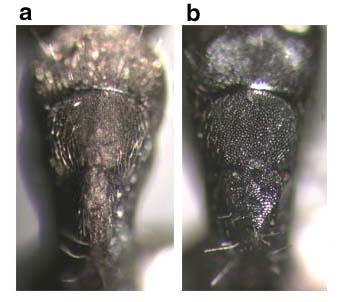
300a. Dorsal and posterior faces of propodeum meeting at a right angle: JTL-035
300b. Dorsal and posterior faces meeting at an obtuse angle or not differentiated: 310

310a. Mesosoma as in group a; relatively elongate; often relatively large, WL of typical minor workers often 3mm or larger (one rare Monteverde species around 2.2mm): 320
310b. Mesosoma as in group b; relatively more compact than group a; WL of typical minor workers around 2.7mm (major workers weakly to strongly phragmotic): 400
310c. Mesosoma as in group c; WL of typical minor workers around 1.7mm (major workers strongly phragmotic): 420
310d. Mesosoma as in group d, compact, shorter and taller than above groups; WL of typical minor workers 1.7-2.4mm (major workers various or absent): 435

320a. Color shiny black throughout, including coxae and legs; propodeum somewhat "U" shaped in cross section, relatively less tectiform than following; size relatively smaller (WL 2.2mm, n=1); scapes with long, suberect pubescence, no erect setae (rare species from Monteverde cloud forest): JTL-042
320b. Color usually yellow to dark red brown, if mesoma nearly black then coxae are contrastingly bright yellow; propodeum strongly tectiform; size relatively larger (WL about 3mm or larger); scape pubescence and pilosity variable: 330
330a. Head in face view widest at mandibular insertions, strongly converging behind to narrow neck with flanged collar; size large (WL 5.7mm, n=1): ager
330b. Head usually subrectangular or widest posteriorly, if widest at mandibular insertions then sides only weakly tapering posteriorly; never converging to constricted neck with a flanged collar: 340
340a. Scapes with abundant long erect setae, many setae longer than width of scape: atriceps
340b. Scapes with no erect setae, or with very few inconspicuous setae, or with dense suberect pubescence that is shorter than width of scape: 350

350a. Scapes with dense suberect pubescence that is shorter than width of scape: JTL-005
350b. Scapes with no erect setae or pubescence, or with very sparse erect setae, if pubescence not fully appressed then short and not conspicuous: 360

360a. Color dark brown with contrastingly bright yellow coxae: 365
360b. Color yellow to red brown, without sharply contrasting yellow coxae: 370
365a. Head of minor worker with sides parallel to slightly converging; head relatively shorter; scapes with fully appressed pubescence only, no erect setae; front coxae entirely yellow: albicoxis
365b. Head of minor worker with sides slightly divergent anteriorly; head relatively longer; scapes with short suberect setae above pubescence; front coxae infuscated on upper third: JTL-048
370a. In face view head widest at mandibular insertions, tapering posteriorly: 375
370b. In face view head subrectangular or widest behind mandibular insertions: 380
375a. Scapes lacking erect setae; mesosoma uniform brown; size variable: 377
375b. Scapes with sparse erect setae; mesosoma with mottled infuscation; WL 3.3mm (n=1): JTL-053
377a. Size large (minor worker WL 4.3mm, n=1): JTL-021
377b. Size small (minor worker WL 2.8mm, n=1): JTL-061
380a. In face view with abundant erect setae projecting from sides of head; head and mesosoma red brown, gaster black with yellow spots: coloratus
380b. Head lacking erect setae on sides of head; color various: 390
390a. Color largely light to dark brown; scapes with or without erect setae: 392
390b. Color mainly yellow with variably developed dark bands on gaster; scapes lacking erect setae: zonatus
392a. Scapes lacking erect setae or with only 1 or 2; pubescence on scape fully appressed: 395
392b. Scapes with short fine suberect setae in addition to short suberect pubescence: JTL-050 [Minor worker of JTL-049, known only from a major worker, may also key near here.]
395a. Head relatively short and rounded behind eyes; scapes relatively short and thick: atypical collection of atriceps
395b. Head relatively elongate behind eyes; scapes relatively long and thin: JTL-004
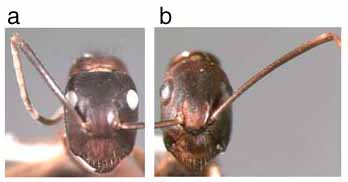
400a. In face view, sides of head with erect setae projecting from sides: 410
400b. Sides of head lacking erect setae: JTL-044
410a. Scapes with long subdecumbent pubescence but no differentiated long erect setae; mesosoma concolorous red brown (major with strikingly phragmotic head): JTL-036
410b. Scapes with several inconspicuous long erect setae in addition to pubescence; pronotum red, mesonotum and propodeum contrastingly darker red brown: JTL-043

420a. Mesosoma red brown, lighter on pronotum than on mesonotum and propodeum; gaster with large ivory spots rimmed in brown: JTL-041
420b. body concolorous yellow: 430

430a. In lateral view, clypeus convex or weakly angulate (major moderately phragmotic, without flat truncation, clypeus convex): claviscapus
430b. In lateral view, clypeus flat (major strongly phragmotic with flat truncation, clypeus entirely contained in flat truncation): curviscapus

435a. Scapes and legs with abundant erect setae; eyes strongly protruding from sides of head; lacking major worker caste; constructs nests of leaves sewn together with silk (subgenus Dendromyrmex): 437
435b. Scapes and legs lacking abundant erect setae; eyes less strongly protruding from sides of head; major worker caste present; nests in live or dead plant stems or in ground: 440

437a. Back of head with small vertex collar or neck; appressed pubescence on first gastral tergite sparse: chartifex
437b. Back of head evenly rounded, with no trace of collar; appressed pubescence on first gastral tergite abundant, dense: nitidior

440a. Body more or less concolorous red; surface mat, not shiny: JTL-013
440b. Body black or variously multicolored, but mesonotum and propodeum always black; surface mat or shiny: 450
450a. Side of mesonotum and propodeum with dense appressed yellow pubescence: blandus
450b. Side of mesonotum and propodeum bare, pubescence restricted to dorsum, extending a short distance or not at all onto sides: 460

460a. Propodeal suture almost or entirely effaced: 470
460b. Propodeal suture present as a distinct suture extending across mesosomal dorsum: 480

470a. Side of mesonotum and propodeum mat; appressed pubescence on first gastral tergite relatively sparse: fastigatus
470b. Side of mesonotum and propodeum shiny; appressed pubescence on first gastral tergite very long and dense: salvini

480a. First gastral tergite with dense appressed pubescence under erect setae: novogranadensis
480b. First gastral tergite with sparse pubescence: JTL-011

500b. Color black: 510
510a. In face view, side of head between mandible and eye with abundant projecting erect setae: 520
510b. Side of head lacking erect setae, or with 1-2 near mandibular insertions: 550
520a. Dorsal and lateral faces of pronotum separated by a distinct carina that runs full length of pronotum; dorsal face of propodeum shorter than posterior face: linnaei
520b. Dorsal face of pronotum rounding into lateral face, not separated by a sharp carina; dorsal face of propodeum subequal in length to posterior face: 530

530a. Mesosomal dorsum with relatively sparse pilosity (minor worker not always distinguishable from JTL-016, major worker with yellow color on anterior half of face or more): cuneidorsus
530b. Mesosomal dorsum with abundant pilosty (major worker face all black or with small amount of yellow near mandibular insertions): 540

540a. Scapes with several inconspicuous erect setae in addition to subdecumbent long pubescence; anterior juncture of dorsal and lateral faces of propodeum relatively more angulate: JTL-016
540b. Scapes with long subdecumbent pubescence only, no erect setae; anterior juncture of dorsal and lateral faces of propodeum relatively rounded: JTL-010
550a. Scapes orange, with pubescence very fine, short, and fully appressed: 560
550b. Scapes light brown or darker, with pubescence longer, more visible, subdecumbent in places: 570

560a. Major and minor workers with no erect setae projecting from sides of head: JTL-015
560b. Major worker with abundant short stiff setae on lower face and projecting from sides of head; minor worker either with no erect setae projecting from sides of head or with 1-3 short setae near mandibular insertions: JTL-027
570a. Mesosoma relatively more compact; dorsal face of propodeum shorter than posterior face; side of propodeum relatively shiny; scapes with abundant subdecument pubescence but lacking erect setae: JTL-030
570b. Mesosoma relatively elongate; dorsal face of propodeum subequal in length to posterior face; side of propodeum feebly punctate; scapes occasionally with a few erect setae: JTL-028
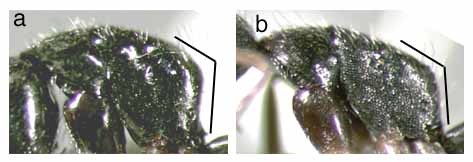
Page author:
John T. Longino, The Evergreen State College, Olympia WA 98505 USA.longinoj@evergreen.edu